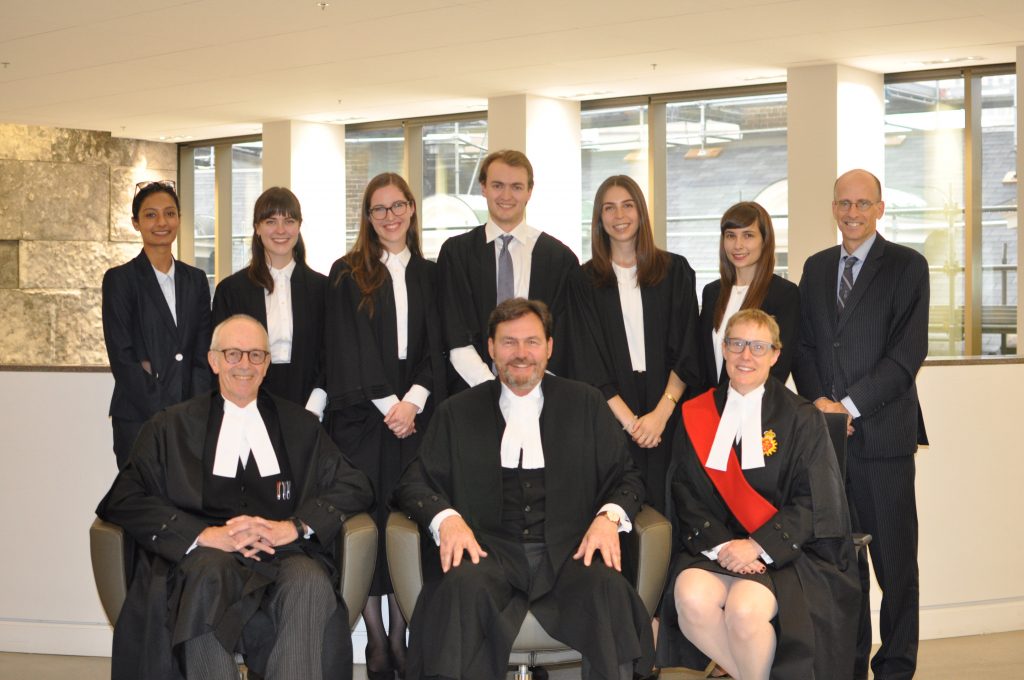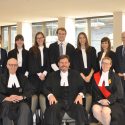When, if ever, is the solitary confinement of prison inmates constitutional? On October 3, 2019, four of the Faculty of Law’s strongest mooters argued this timely question before a distinguished panel of judges comprised of the Honourable Chief Justice of Canada Richard Wagner, the Honourable Chief Justice of Ontario George Strathy, and the Honourable Justice of the Ontario Superior Court of Justice Breese Davies. The occasion was the Faculty’s annual Grand Moot.
Every autumn, the Moot Court Committee, the student organization responsible for the Faculty’s mooting program, puts on the Grand Moot. The Grand Moot is a ceremonial, internal moot, sponsored by McCarthy Tétrault LLP. It serves as an opportunity for the Faculty to showcase the high level of advocacy it strives to foster and for participants the chance to hash out compelling legal issues before accomplished judges.
This year, the mooters were Eileen Church Carson (3L), Spence Colburn (3L), Julie Lowenstein (3L) and Will Maidment (2L). They secured their spots on the moot through tryouts that occurred in mid-March. When I asked the mooters what made them want to do the Grand Moot—a process that requires participants to prepare through August and September—Lowenstein said:
We had learned so much about written and oral advocacy from our previous mooting experiences and wanted to continue gaining hands-on [experience]. The Grand Moot is also typically about interesting and current issues in constitutional or public law, and we thought it would be a unique opportunity to engage with these issues in front of a panel of esteemed judges.

The Problem
This year’s Grand Moot problem involved a constitutional challenge to the fictional Structured Intervention Act. Flavelle, a fictional country similar to Canada, enacted the Structured Intervention Act to replace its previous system of administrative and disciplinary segregation which provided for solitary confinement. Pursuant to the fictional Act, prison inmates could be removed from the general inmate population and placed into a “structured intervention unit” (SIU). Inmates placed in these SIUs were entitled to a minimum of four hours outside their cell, with at least two of those hours to be allotted for socialization.
However, compliance with those minimum requirements was subject to a number of exceptions. Consequently, certain inmates could be subjected to solitary confinement for indefinite periods of time. This raised questions about whether the Act might violate inmates’ Charter rights to life, liberty and security of the person, and against cruel and unusual punishment.
Student Co-Chief Justices of the Grand Moot, Su Rao (3L) and Alysa Holmes (3L) conceived this problem in response to Bill C-83 — An Act to amend the Corrections and Conditional Release Act, which provides for inmate segregation. Indeed, Flavelle’s Act contained language which was similar (but not identical) to language in Bill C-83.
Two recent cases, — British Columbia Civil Liberties Association v Canada, 2018 BCSC 62, and Canadian Civil Liberties Association v Canada, 2019 ONCA 243 — also inspired this year’s Grand Moot problem. In those cases, the respective courts struck down systems of administrative segregation that paralleled the one that existed under Flavelle’s previous segregation legislation, because they permitted prolonged and indefinite solitary confinement. Indeed, at the end of the moot, Strathy CJ quipped that the issues gave him a sense of déjà vu (he presided over the CCLA case at the Ontario Court of Appeal.)
The Moot
The Grand Moot’s problem gave rise to three main issues.
First, did the Structured Intervention Act infringe the rights of inmates under section 7 of the Canadian Charter of Rights and Freedoms (which applies in the country of Flavelle)? Section 7 guarantees all Flavellians the right to life, liberty and security of the person.
Second, did the Act infringe the rights of inmates under section 12 of the Charter? Section 12 guarantees all Flavellians the right not to be subjected to any cruel or unusual treatment or punishment.
Third, if the Act infringed either section 7 or section 12, was that infringement justified under section 1 of the Charter? Section 1 guarantees the rights and freedoms set out in the Charter “subject only to such reasonable limits prescribed by law as can be demonstrably justified in a free and democratic society.”
In the Grand Moot, Colburn and Lowenstein represented the Appellant, the Flavellian Civil Liberties Association. They argued on its behalf that the Act violated inmates’ section 7 and 12 Charter rights, and that it could not be saved under section 1. Essentially, the Appellant argued that the Act thwarted the human “need to connect”, harming some of Flavelle’s most vulnerable citizens.
Speaking on section 7, Lowenstein argued that the Act engaged inmates’ liberty interests because it enabled prison staff to place and keep them in SIUs without their consent. The Appellant team also argued that the Act engaged inmates’ right to security of the person. Lowenstein relied on empirical studies to show that solitary confinement frequently causes inmates physical suffering as well as severe psychological reactions. Inmates’ limited access to competent medical care under the Act further compounded these problems.
Colburn addressed section 12. She explained that “a law will violate section 12 where it imposes treatment that is grossly disproportionate to what would ordinarily be appropriate in the circumstances, or where the law’s reasonably foreseeable applications would impose such treatment.” The Appellant argued that the impugned Act violated section 12 because, like its predecessor, it provided for prolonged and indefinite solitary confinement; that deprives inmates of the social interaction and environmental stimulus they need to maintain their immediate and long-term mental health.
Colburn then briefly turned to section 1. She conceded, on behalf of the Appellant, that the need to maintain the safety of a general inmate population is a pressing and substantial objective. However, the harms that prolonged segregation cause precluded the possibility of the Act being minimally impairing.
Church Carson and Maidment represented the Respondent, the Attorney General of the country of Flavelle. They argued, on behalf of Flavelle, that the Act did not violate either section 7 or section 12 of the Charter; in the alternative, if the Act did violate those sections, the infringement was justified under section 1.
Maidment opened for the Respondent. He conceded that the Act engaged inmates’ liberty interest, but only for the important objectives of maintaining safe and secure prisons. Maidment also argued, on behalf of the Respondent, that there was insufficient evidence that the Act infringed inmates’ right to security of the person; the studies on which the Appellant relied all dealt with Flavelle’s previous segregation regime. The current Act addressed its predecessor’s constitutional shortcomings, providing inmates with more time outside their cells and better access to healthcare. Maidment argued, in any event, that there were ample review procedures for the administrators’ discretion, including curial review via writs of habeas corpus.
Maidment then addressed how the deprivation of liberty under the Act accorded with the principles of fundamental justice. Both parties agreed that the Act had compelling objectives: securing inmates’ and prison staff’s safety and protecting the integrity of ongoing investigations into criminal or serious disciplinary offences. Maidment contended, on the Respondent’s behalf, that the Act was not overbroad and that although challenges such as transferring inmates between institutions or lockdowns, might extend an inmate’s isolation, those procedures were themselves grounded in security and safety concerns.
Finally, Church Carson presented the Respondent’s section 12 arguments. She conceded that placing an inmate in a SIU would be an exercise of state power that constitutes “treatment” within the meaning of section 12. However, she emphasized that “cruel and unusual” is a high bar to meet. Although solitary confinement could meet that threshold in some circumstances, it would not in cases where an inmate posed a serious danger to prison staff or other inmates, or where segregation protected the inmate from harm.
Church Carson also underscored the Respondent’s position that the prison officials’ discretion was limited to what was “reasonably required for security purposes.”
In the final part of her submissions, Church Carson dealt with section 1. She conceded that the threshold of gross disproportionality under section 12 is so high that a law that meets this threshold is likely also disproportionate under section 1. However, she argued, on behalf of the Respondent, that a violation of section 7 could nevertheless be justified. The thrust of the Respondent’s position was that, even if the Act failed to conform with the principles of fundamental justice in its interaction with particular inmates, it would be justified by the social good it conferred on Flavelle’s public. Namely, mitigating the violent conflict endemic to prison populations.
Following their submissions, the judges commended the mooters for their solid grasp of the issues of the case and of their own arguments on those issues. Chief Justice Wagner said that the mooters showed great promise as future litigators, because they had already mastered some of the key aspects of compelling argument: eye contact and an easy, conversational demeanour. The other justices echoed that sentiment, saying that they looked forward to seeing these capable oralists in their own courtrooms. You can watch the Grand Moot in its entirety on the Faculty of Law’s website.






